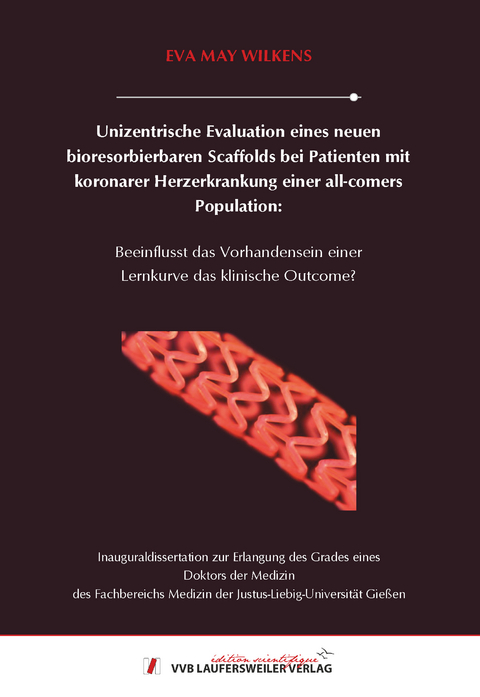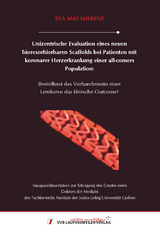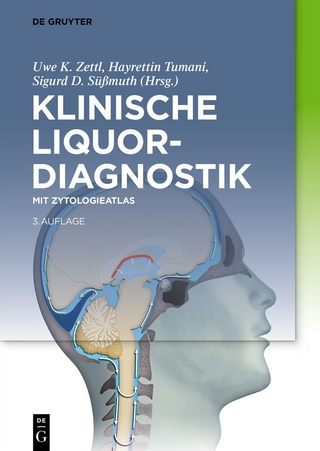Beeinflusst das Vorhandensein einer Lernkurve das klinische Outcome?
Seiten
2021
VVB Laufersweiler Verlag
978-3-8359-6992-6 (ISBN)
VVB Laufersweiler Verlag
978-3-8359-6992-6 (ISBN)
- Keine Verlagsinformationen verfügbar
- Artikel merken
Derzeit verfügbare Koronarstents, die auf Metall basieren, stellen zwar eine gute akute Revaskularisierungsmöglichkeit dar, sind allerdings aufgrund eines lebenslangen Verbleibens im Gefäß und nachfolgenden chronischen Inflammationsprozessen mit Limitationen behaftet. Dementsprechend wurden bioresorbierbare Scaffolds wie der Absorb entwickelt, die jedoch bisher den geringen Ereignisraten der als Goldstandard geltenden Drug-Eluting-Stents nicht entsprechen konnten. Sie wurden aufgrund des häufigeren Auftretens von Endpunkten wie TLF (Zielläsionsversagen), TVF (Zielgefäßversagen), MACE (Major Adverse Cardiac Events) und ScT (Scaffoldthrombosen) 2017 wieder vom Markt genommen. Dennoch besteht der klinische Bedarf an die Technologie einer bioresorbierbaren Gefäßstütze weiterhin.
Daher sollte in dieser Arbeit untersucht werden, ob das Vorhandensein einer Lernkurve Einfluss auf die Häufigkeit der oben genannten Endpunkte in der klinischen Routine nimmt.
In die Studie wurden Daten von 300 Patienten des all-comers Absorb Registers eingeschlossen, bei denen der bioresorbierbare Scaffold Absorb zur Behandlung einer signifikanten Koronarstenose implantiert wurde. Es wurde dabei zwischen einer ersten Gruppe (n=150), die zu einem früheren Zeitpunkt behandelt wurde und einer zweiten Gruppe (n=150), deren Patienten später mit einem Absorb versorgt wurden, unterschieden. Analysiert wurde das Auftreten der Endpunkte TLF (Zielläsionsversagen), TVF (Zielgefäßversagen), MACE (Major Adverse Cardiac Events) und ScT (Scaffoldthrombosen).
Nach einem Follow-up von 12 Monaten traten in der zweiten Gruppe alle prädefinierten Endpunkte seltener auf. Statistisch signifikant zeigte sich dies insbesondere bei den Endpunkten TVF (12% vs. 4,7%, p=0,035), MACE (13,3% vs. 6%, p=0,032) und ScT (3,3% vs. 0%, p=0,024). Als potenzielle Einflussgrößen wurden die verbesserte Läsions- und Patientenauswahl, sowie die Entwicklung einer spezifischen Implantationstechnik identifiziert. Weiterhin zeigte sich der Einsatz intravaskulärer Bildgebung in Form einer optischen Kohärenztomografie (OCT) vorteilhaft.
Zusammenfassend konnte in dieser Arbeit bei dem Vergleich beider zu unterschiedlichen Zeitpunkten behandelten Gruppen das Vorhandensein einer Lernkurve gezeigt werden, die das klinische Outcome beeinflusst. Daraus lässt sich ableiten, dass zukünftig bei dem Einsatz neu entwickelter bioresorbierbarer Scaffolds eine definierte Läsions- und Patientenauswahl sowie entsprechende Implantationstechniken beachtet werden müssen. Currently available metal-based coronary stents represent a good standard of revascularization. They have the disadvantage of staying in the vessel for a lifetime leading to chronic inflammation resulting in limitations of the technique. Therefore bioresorbable Scaffolds like the Absorb have been introduced, whereas their outcome has not been able to match with the low event rates of Drug-Eluting-Stents presenting the gold standard so far. Because of higher event-rates regarding endpoints like TLF (target lesion failure), TVF (target vessel failure), MACE (major adverse cardiac events) and ScT (scaffold thrombosis) commercial sales of the Absorb ended in 2017. Nevertheless, the clinical need for bioresorbable vascular stent technology is still persistent.
Accordingly, the purpose of this investigation was to evaluate whether there is evidence of a learning curve and how it’s presence influences the endpoints named above in routine clinical practice.
The study included data of 300 patients of the all-comers Absorb registry who underwent BRS implantation of the Absorb treating significant coronary stenosis. The cohort was divided in two groups: The first 150 consecutive patients treated on an earlier date were compared with the second group of 150 patients, that were treated later. Target endpoints were TLF (target lesion failure), TVF (target vessel failure), MACE (major adverse cardiac event) and ScT (scaffold thrombosis). All predefined endpoints occurred less frequently in the second group after a follow-up of 12 months.
TVF (12% vs. 4.7%, p=0.035), MACE (13.3% vs. 6%, p=0.032) and ScT (3.3% vs. 0%, p=0.024) showed significantly lower rates at this time. Improved lesion and patient selection, as well as the development of a specific implantation technique were identified as potentially associated to better clinical results. Furthermore, the use of intravascular imaging with optical coherence tomography (OCT) might be useful for further improvement.
In conclusion, the comparison of the two groups treated at different times in this study demonstrated the presence of a learning curve influencing the clinical outcome. Therefore, it can be concluded that in the future a defined lesion and patient selection as well as appropriate implantation techniques have to be considered when using newly developed bioresorbable scaffolds.j
Also the present study showed that an improved implantation technique that was derived from the shown learning curve as well as an increased use of intravascular imaging can lead to better outcomes. ScT rate could be reduced from 3.3% in the first treated group (n=150) of patients to 0% in the second group (n=150). Also other examined endpoints such as MACE, TVF and TLF were less common in the second treated group.
In addition to improved implantation techniques, an extensive duration of the dual antiplatelet therapy up to 3 years should be considered after calculating risks and benefits. Seeing that complete resorption of BRS can take up to 4 years, results of further studies with long-term follow-up need to be analyzed in order to illustrate potential long-term benefits of BRS.
Around 20 years have passed since DES were introduced to the market, a time period where lots of further improvements could be made and lessons be learnt. Back then similar discussions regarding their safety and efficiency took place.
Overcoming technical barriers continues to require time, time that needs to be spent into further development of the idea of a bioresorbable stent in the future.
Daher sollte in dieser Arbeit untersucht werden, ob das Vorhandensein einer Lernkurve Einfluss auf die Häufigkeit der oben genannten Endpunkte in der klinischen Routine nimmt.
In die Studie wurden Daten von 300 Patienten des all-comers Absorb Registers eingeschlossen, bei denen der bioresorbierbare Scaffold Absorb zur Behandlung einer signifikanten Koronarstenose implantiert wurde. Es wurde dabei zwischen einer ersten Gruppe (n=150), die zu einem früheren Zeitpunkt behandelt wurde und einer zweiten Gruppe (n=150), deren Patienten später mit einem Absorb versorgt wurden, unterschieden. Analysiert wurde das Auftreten der Endpunkte TLF (Zielläsionsversagen), TVF (Zielgefäßversagen), MACE (Major Adverse Cardiac Events) und ScT (Scaffoldthrombosen).
Nach einem Follow-up von 12 Monaten traten in der zweiten Gruppe alle prädefinierten Endpunkte seltener auf. Statistisch signifikant zeigte sich dies insbesondere bei den Endpunkten TVF (12% vs. 4,7%, p=0,035), MACE (13,3% vs. 6%, p=0,032) und ScT (3,3% vs. 0%, p=0,024). Als potenzielle Einflussgrößen wurden die verbesserte Läsions- und Patientenauswahl, sowie die Entwicklung einer spezifischen Implantationstechnik identifiziert. Weiterhin zeigte sich der Einsatz intravaskulärer Bildgebung in Form einer optischen Kohärenztomografie (OCT) vorteilhaft.
Zusammenfassend konnte in dieser Arbeit bei dem Vergleich beider zu unterschiedlichen Zeitpunkten behandelten Gruppen das Vorhandensein einer Lernkurve gezeigt werden, die das klinische Outcome beeinflusst. Daraus lässt sich ableiten, dass zukünftig bei dem Einsatz neu entwickelter bioresorbierbarer Scaffolds eine definierte Läsions- und Patientenauswahl sowie entsprechende Implantationstechniken beachtet werden müssen. Currently available metal-based coronary stents represent a good standard of revascularization. They have the disadvantage of staying in the vessel for a lifetime leading to chronic inflammation resulting in limitations of the technique. Therefore bioresorbable Scaffolds like the Absorb have been introduced, whereas their outcome has not been able to match with the low event rates of Drug-Eluting-Stents presenting the gold standard so far. Because of higher event-rates regarding endpoints like TLF (target lesion failure), TVF (target vessel failure), MACE (major adverse cardiac events) and ScT (scaffold thrombosis) commercial sales of the Absorb ended in 2017. Nevertheless, the clinical need for bioresorbable vascular stent technology is still persistent.
Accordingly, the purpose of this investigation was to evaluate whether there is evidence of a learning curve and how it’s presence influences the endpoints named above in routine clinical practice.
The study included data of 300 patients of the all-comers Absorb registry who underwent BRS implantation of the Absorb treating significant coronary stenosis. The cohort was divided in two groups: The first 150 consecutive patients treated on an earlier date were compared with the second group of 150 patients, that were treated later. Target endpoints were TLF (target lesion failure), TVF (target vessel failure), MACE (major adverse cardiac event) and ScT (scaffold thrombosis). All predefined endpoints occurred less frequently in the second group after a follow-up of 12 months.
TVF (12% vs. 4.7%, p=0.035), MACE (13.3% vs. 6%, p=0.032) and ScT (3.3% vs. 0%, p=0.024) showed significantly lower rates at this time. Improved lesion and patient selection, as well as the development of a specific implantation technique were identified as potentially associated to better clinical results. Furthermore, the use of intravascular imaging with optical coherence tomography (OCT) might be useful for further improvement.
In conclusion, the comparison of the two groups treated at different times in this study demonstrated the presence of a learning curve influencing the clinical outcome. Therefore, it can be concluded that in the future a defined lesion and patient selection as well as appropriate implantation techniques have to be considered when using newly developed bioresorbable scaffolds.j
Also the present study showed that an improved implantation technique that was derived from the shown learning curve as well as an increased use of intravascular imaging can lead to better outcomes. ScT rate could be reduced from 3.3% in the first treated group (n=150) of patients to 0% in the second group (n=150). Also other examined endpoints such as MACE, TVF and TLF were less common in the second treated group.
In addition to improved implantation techniques, an extensive duration of the dual antiplatelet therapy up to 3 years should be considered after calculating risks and benefits. Seeing that complete resorption of BRS can take up to 4 years, results of further studies with long-term follow-up need to be analyzed in order to illustrate potential long-term benefits of BRS.
Around 20 years have passed since DES were introduced to the market, a time period where lots of further improvements could be made and lessons be learnt. Back then similar discussions regarding their safety and efficiency took place.
Overcoming technical barriers continues to require time, time that needs to be spent into further development of the idea of a bioresorbable stent in the future.
| Erscheinungsdatum | 10.01.2022 |
|---|---|
| Reihe/Serie | Edition Scientifique |
| Verlagsort | Gießen |
| Sprache | deutsch |
| Maße | 148 x 210 mm |
| Gewicht | 150 g |
| Themenwelt | Medizin / Pharmazie ► Medizinische Fachgebiete ► Laboratoriumsmedizin |
| Schlagworte | Herz • Koronarerkrankung • Stent • Thrombose |
| ISBN-10 | 3-8359-6992-7 / 3835969927 |
| ISBN-13 | 978-3-8359-6992-6 / 9783835969926 |
| Zustand | Neuware |
| Haben Sie eine Frage zum Produkt? |
Mehr entdecken
aus dem Bereich
aus dem Bereich
Buch | Softcover (2021)
Deutscher Ärzteverlag
CHF 41,95
mit Zytologieatlas
Buch | Hardcover (2025)
De Gruyter (Verlag)
CHF 244,90
ein praxisorientiertes Handbuch
Buch | Hardcover (2023)
Wiley-VCH Verlag GmbH
CHF 69,85




